|
|
Hobo
|
Name:
|
Hobo |
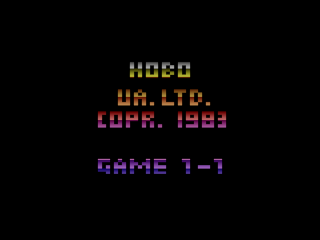 |
| Company: | UA Ltd. | |
|
Model #:
|
3 | |
|
Programmer:
|
Unknown | |
| Year: | 1983 | |
|
Released?
|
No
|
|
|
Notes:
|
A retail box, manual, and cartridge were found in 2011 |
Hobo was one of six different games UA Ltd. was planning on
releasing for the 2600 based on their offerings for the Arcadia
2001. For those not in the know, the Arcadia 2001 was an
obscure home game system released in 1982. To say that the
Arcadia 2001 didn't take the market by storm would be an
understatement, but it was much more popular overseas where
dozens of different clones were marketed. However due to
the video game crash UA decided not release any of their games,
either in the U.S. or in Europe. Interestingly Hobo, along
with Pleiades, R2D Tank, and Funky Fish were never released in
the U.S. for the Arcadia 2001. These titles only saw
release in Europe and Canada for various clone systems.
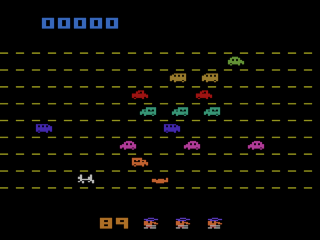
Hobo is an interesting action game with
three different screens. Unlike most of UA Ltd.'s games,
Hobo was an original idea, not an obscure arcade port or knock
off. Oddly enough the box says that the game was a
'licensed arcade game', but this is not the case and is most
likely a result of using one of the other UA cartridge boxes as
a template. The goal of the game is to safely guide your
hobo through three screens of increasing danger in order to get
to the other side of the Grand Central Railway Station and catch
a train out of town.
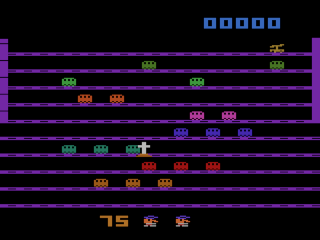
Screen one finds our lovable hobo trying to
cross a busy freeway in front of the railway station. This
screen is fairly straight forward, dodge cars and make it to the
other side. This screen was obviously inspired by Frogger,
and is the simplest of the three. While you can move the
Hobo left and right, it's generally better to just make a
straight run for it to the other side, pausing as necessary as
the cars are rather fast. If the Hobo gets hit he'll be
carted off the screen by two men carrying a stretcher.
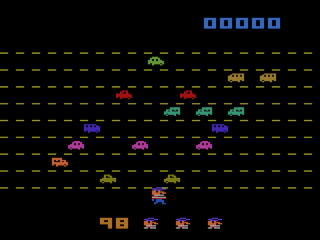
Screen two shakes things up a bit and finds
our hobo trying to scale a series of walls in order to reach the
railway station itself. The manual refers to this screen
as a 'fortress' which really doesn't make any sense, and the
artwork clearly shows the hobo scaling a wall. Each of the
three wall platforms is connected by a series of ladders that
the hobo can climb. Each platform is also patrolled by a
group of two or three cops who will constantly march down and
off the screen only to reappear at the top. Thankfully
your hobo can jump over the cops if they get to close, but often
times it's just easier to time your movements and avoid them all
together as you'll hang up in the air for a rather long amount
of time. Unlike in the Arcadia version of the game, the
goal is not to get to the top of the screen but rather to
collect all the items on the various platforms. Once
you've collected all the items you'll be taken to the next
screen. In a nice little bit of eye candy, if the Hobo
gets caught by the police he'll be carted off to jail.
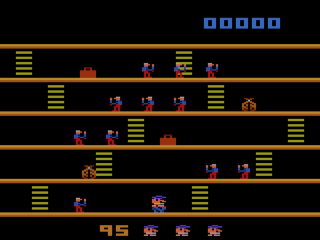
Screen three is the most interesting of the
bunch. Here you must guide your hobo over a series of
trains (I guess he's running on top of them) as they scroll
across the screen. There are eight different lines of
trains you need to jump across in order to reach the handcart at
the top of the screen which will allow you to get out of
town. The first four rows have no walls on the sides so
you're safe to scroll off the sides of the screen. However
the last four have walls which you'll splat against if you do
not move quickly enough. Be aware that there's a small
delay in the movement from row to row, so you can't move too
quickly. There also seems to be a bug in the collision
detection between the Hobo and the trains, so sometimes you'll
look like you've safely reached a train but the game will still
think you've missed. If you succeed in reaching the top
you'll start back at screen one with everything moving a little
faster. Like the other screens, there's a bit of eye candy
if you die. On this screen if you miss a train a little
cross will appear where the Hobo died.
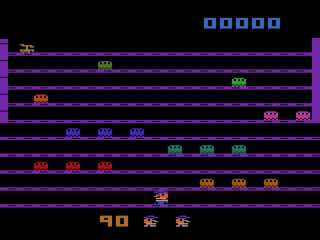
Hobo offers the standard options that most
UA games did. The player can either play through all three
levels in order (Game 1) , choose to play only one screen over
and over again (Games 2-1, 2-2, and 2-3), or play a particular
screen over and over but with infinite lives (Games 3-1. 3-2.
and 3-3). This allows the player to practice a certain
screen or just skip screens they don't like. The game can
also be paused with the Color/B&W switch. The game
even features a demo which wasn't particularly common at the
time. One odd quirk in the game is that it will display
the title screen between each screen and won't advance until the
player pushes the fire button. This was most likely to
give the player a breather between screens, but it's still
somewhat odd if you're not expecting it. In keeping with
the game variation numbering, each level is referred to as 1-1,
1-2, or 1-3.
.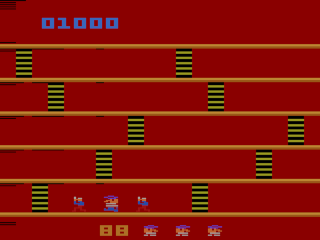
While each of Hobo's individual screens isn't particularly great, they do form a nice little game when put together. Hobo is one of the more advanced UA games and required 8K where most of the others were only 4K (Pleiades was also 8K). Interestingly the box art for the 2600 release of Hobo is completely different from the Arcadia release. Why UA decided to create new artwork for the 2600 port is unknown as they used the original Arcadia artwork for the other titles.
Retail Box (Front)
Retail Box (Back)
Retail Box (Side)
Retail Cartridge
Manual and Cartridge
